Zürich
Switzerland has – for as long as I can remember – been very much on my to-do list, but far too readily shunted down the agenda in place of other destinations. It was time for Holly and I to put that right.
The difficulty came, however, working out where in this land-locked nation to spend our time. Do we go for the de-facto capital Bern (Switzerland doesn’t have an official capital city which is one of its many quirks), or do we head for quaint city of Basel in the north-west region of the country?
In the end my decision was to go to neither of these and instead head to the picturesque city of Zürich.
Zürich is the largest city in Switzerland and the capital of the canton of Zürich. Switzerland is split into 26 cantons that each are a member state of the Swiss Confederation which make up the country as a whole.
As of January 2020, around 1.8 million people call the Zürich metropolitan area, home. Both Zürich Airport and Zürich’s main railway station are the largest and busiest in the country.
The city is situated with a stunning mountain backdrop while sitting atop of a beautiful lakeside vista. This idyllic city has seen settlements from the Neolithic and Bronze Ages found around its lake, with many other finds from different eras also being uncovered.
In fact, Zürich’s origins as a town date back to 15BC, when the Roman town of Turicum was established to oversee trade passing through the Alps.
But aside from its beauty and its history, this city offered us, as travellers, another great reason to pick it over other Swiss locations. It’s proximity to the Principality of Liechtenstein (more on that later).

So what should a first time traveller to Zürich know before setting off to this Swiss canton?
The first thing to note – more for interest than practicalities – is that Switzerland is a landlocked country in the heart of Europe with five different borders (France, Germany, Italy, Austria and Liechtenstein).
If you plan to hire a car – or get on a train – to go to any of these countries then make sure you keep your passport with you to avoid any issues when crossing in and out of Switzerland. The one main exception to this is passing into Liechtenstein as there is no hard border here, but I’d still advise taking your passport with you in order to get a passport stamp put into your document at one of the local shops or tourist information centres.
Knowing what type of weather to expect in Zürich during a visit is key to ensuring travellers remain comfortable.
Zürich itself lies in the temperate climate zone and has four distinct seasons. In winter, temperatures occasionally drop below zero and can be rainy and cold (although not always snowy), while hot summer days can record temperatures of over 30°c.
Our visit was during April so we had a very mixed forecast. To one extent the weather would be comfortable t-shirt weather, while at the other end there were a few rain showers in the making and a chilly wind. It made packing that bit harder. On top of this, we also wanted to venture out of the city and into the mountains during our trip. This meant that we were going to need hats and coats to stay warm and dry.
If you go at a similar time of year then I’m afraid the best bet is to pack for all eventualities. It’s unlikely you’ll need shorts but a warm coat and long-sleeved tops and trousers are a must.
The next thing to think about is the currency. The Swiss franc is the official currency of Switzerland as well as in Liechtenstein. At the time of writing, £1 sterling would get you around CHF1.22.
Traditionally, Switzerland has been very cash-orientated over the years with many transactions taking place in hard currency. However, this is beginning to change and we found, on more than one occasion, stops and restaurants wanting card payments only. Therefore, travellers need to make sure that take their credit cards with them when they head out.
If you are travelling from England, then there is only one time zone difference to take into consideration with Switzerland being one hour ahead of the UK. This means you’ll lose and hour on your travel to the country but gain it back when you return.

One thing you learn about Switzerland very early into a trip is that they don’t like to follow the trends of other countries! A prime example of this is their plug points.
Switzerland uses type C (2-pin) and Type J (3-pin) plugs. (Type C 2-pin plugs also fit J sockets.) Most power sockets are designed for three pin round plugs. The latter of these two plug types is almost exclusively used by Switzerland and Liechtenstein and is the more common one – in my experience – to find in the country. Therefore, make sure you take the right plug converters out with you before you travel in order to keep your devices charged up.
Holly and I failed to do this and had a mad panic early search in the local shops in Zürich to find a plug converter as this had totally slipped our mind in our pre-departure preparations.
Aside from this – and just to make life simple – Switzerland has four national languages to contend with.
The main one of these that is used is German which is spoken by 62.8% of the population. The second is French (22.9%) which is mainly used in the west part of the country near the French border. The third is Italian (8.2%) which is used a bit in the south near the Italian boarder while the fourth national language is Romansh (0.5%) and is spoken locally in the south-eastern trilingual canton of Grisons.
While English is not a staple of Swiss life, a lot of people we came into contact with had a very good grasp of the English language and when our poor grasp of German let us down, they quickly jumped to our rescue in our home tongue. Many restaurants in the city will also have an English-language menu for you to read if you request it when you sit down.
As ever, I always think it best to at least have some of the basics of the local language to hand. So just knowing (in German) the likes of hello (hallo), goodbye (auf Wiedersehen), please (bitte) and thank you (danke) can be a massive help.
Now all there is to do is enjoy everything that Switzerland has to offer.
Getting there
Getting to Zürich is an easy task from the UK with flight times from London being in the region on of an an hour and 45 minutes to a maximum of two hours.
As a major hub of Swiss aviation, there are plenty of flight operators who fly in and out of Zürich with many going to destinations in the UK including London Heathrow, London Gatwick, London City, London Luton and Manchester
The main choices to fly from the UK are the Swiss airline, Swiss International Air Lines or the budget operator, EasyJet.
For our trip we chose to fly with the latter as prices and times were best and we could travel from London Gatwick.
It’s worth saying up front that you’re unlikely to find extremely cheap flights to Switzerland. However, if you’re looking for a cheap location to go to then it’s best to go somewhere else.
For £258.92 we booked two return flights to Zürich – including speedy boarding – for our April trip.
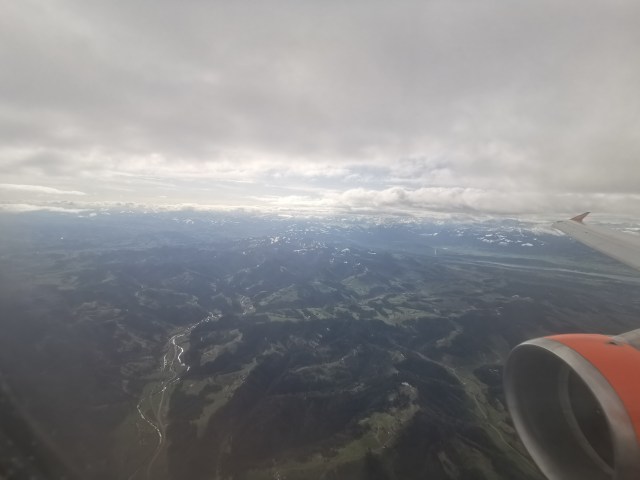
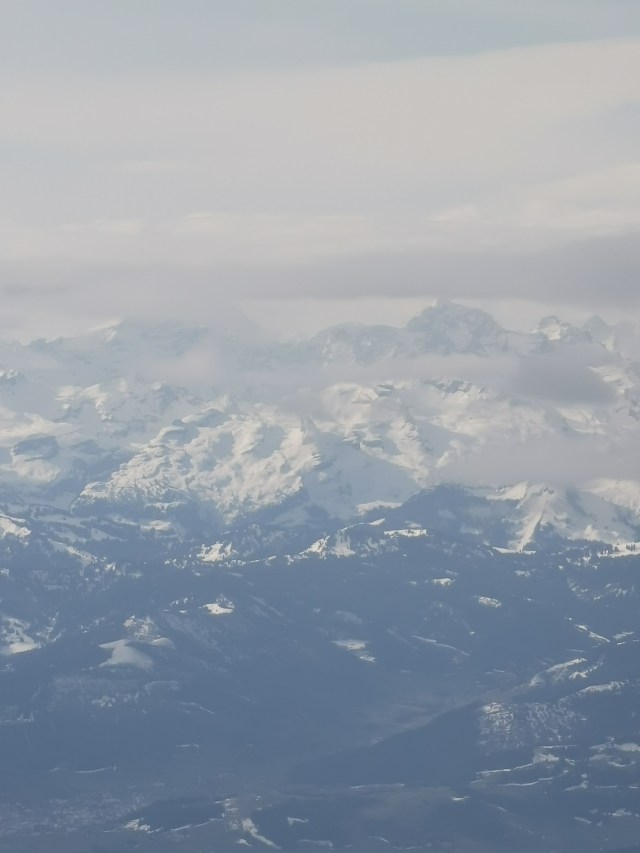
Zürich Airport is the largest international airport of Switzerland and – pre-Covid-19 – around 30 million people would traverse through its gates each year. And while that figure is beginning to recover, recent statistics at the time of writing suggest that figures are only around a third of that in the immediate years of the pandemic.
The airport is well located for getting in and out of the city and is around 13km – or eight miles – north of central Zürich.
There are three runways that service the three main terminals within the airport known as terminals A, B, and E (also signposted as Gates A, B/D, and E). These are linked to a central air-side building called Airside Centre, that was built back in 2003.
On arrival at the airport, and once through security, travellers find themselves in something of a maze of walkways, escalators restaurants and shops. It’s like you come out into a shopping centre that also has a train station attached to it!
Holly and I found ourselves walking slightly aimlessly for a short time as we looked for where we could catch a train to the city centre. However, this was probably more down to us being poor navigators than Zürich Airport being overly complicated. It seemed that everyone else knew exactly where they were heading!
The airport is a good hub for a lot of things. There are storage lockers to store bags should you need to, the aforementioned train station that takes you into Zürich very quickly as well as a variety of car hire operators (more on them later) that can give you access to areas beyond the city.
Where to stay
Zürich has an abundance of great places to stay as is the case with all major cities. However, if you want to stay near the centre of the city you are going to pay premium prices for both hotels and other accommodation.
For our trip, Holly and I opted for another AirBnB right in the centre that boasted riverside views just opposite the Rathausbrücke pedestrian bridge and above a selection of shops.
The entrance to the apartment was a single door that looks like a business entrance. Inside the door sits the entrance to a lift that then takes you to the sixth floor where the apartment is housed.
For our accommodation we paid a hefty £422.98 for three nights – equating to £140.99 a night. This may seem a lot but for a similar location in a nearby hotel, you’d end up probably paying more.


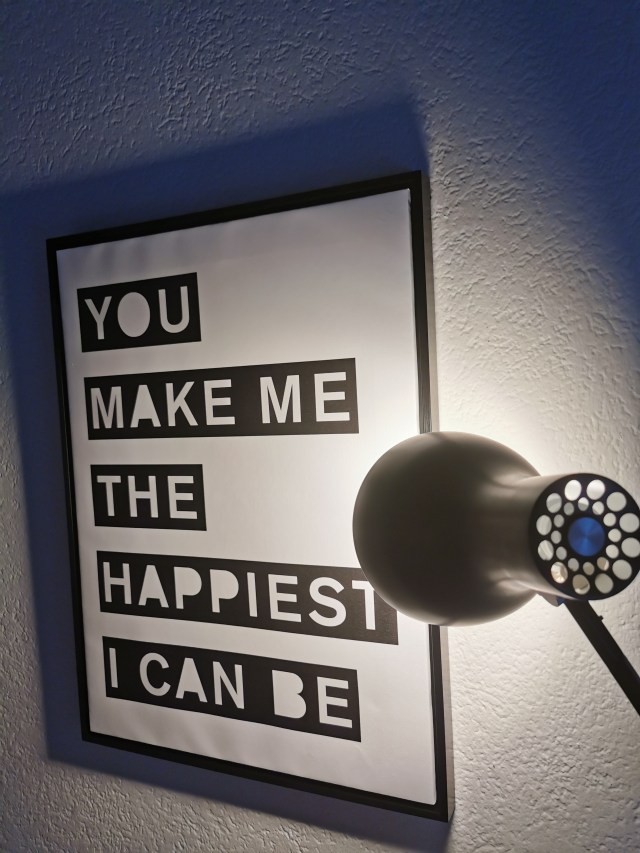

I’ll be honest, the facilities within this compact AirBnB are basic. There was no TV and the whole apartment is a single room with a small bathroom just off the entranceway.
The bed is large and comfortable (although it is two singles pushed together to make a double; so beware of the small gap), and the plugs are plentiful. However, I will remind you again that the Swiss operate on a different plug system to 99.9% of the rest of the world, so make sure you have the right connectors with you before departing. This was something Holly and I didn’t do so spent the first hour or so looking around shops to get a few adapters so our devices didn’t run out of power on the first day!
Small mishap aside, what makes this AirbnB worth staying in, is that it is a short, pleasant walk away from the edge of Lake Zürich and some of the city’s top attractions, as well as a host of fun restaurants, bars and shops.
It also has a stunning apartment-length window that allows you to see great vistas of the surrounding city by day and night. This window into Zürich was how Holly and I started each morning having grabbed some breakfast items from a nearby shop. We could sit by the window eating our morning meal while watching the city slowly wake-up.
It made for a great start to each of our days and got us ready to go out and explore.
Getting around
There are many convenient and easy ways of getting around in Zürich but the cheapest and best way to see the city is by simply walking it.
The city is a beautiful, clean haven to explore and walking its many streets gives you a great chance to see all it has to offer.
A top tip is to head towards the lake and take a stroll around a part of the edge. The views are stunning and the land is relatively flat meaning that it is fairly easy for everyone to meander along.
If you are planning to walk around, be prepared for sudden changes in the weather. Rain does fall on a semi-regular basis a lot of the year and you can suddenly find yourself soaking wet with very little shelter. An umbrella and rain mac can be a lifesaver.


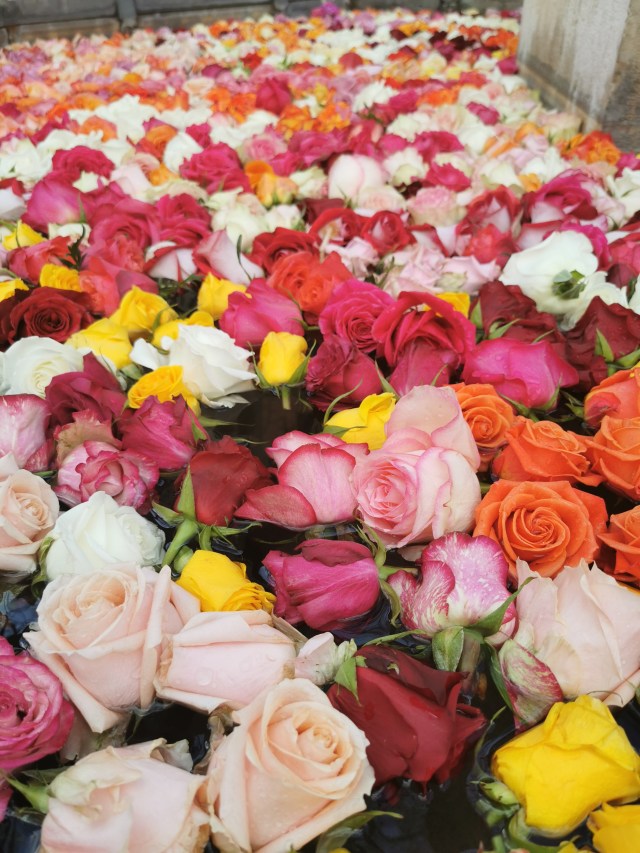
The second mode of transport that most visitors to Zürich will consider is that of the city’s superb trains.
There are many routes to take but the one most travellers will frequent is the quick 15 – 20 minute journey from the airport to the city centre (arriving at the city’s main train station; Zürich Hauptbahnhof.
Zürich’s train network is one of the most sophisticated public transportation systems of Europe. From the airport, the network offers numerous train and metro lines to Zürich HB station, which is located in the heart of Zürich. The price for a regular one way ticket for adults is CHF6.80 (working out around £5.83). The waiting time is normally under five minutes between available trains and the whole network operates from 5am until 12:45am.
The train station is located on the underground level when coming out of the arrivals terminal of the airport. Clear signs will direct you to the appropriate platforms heading to the centre of the city.
Also for those wanting to explore more of Switzerland, without hiring their own car, will most likely use this station to get elsewhere within the country.

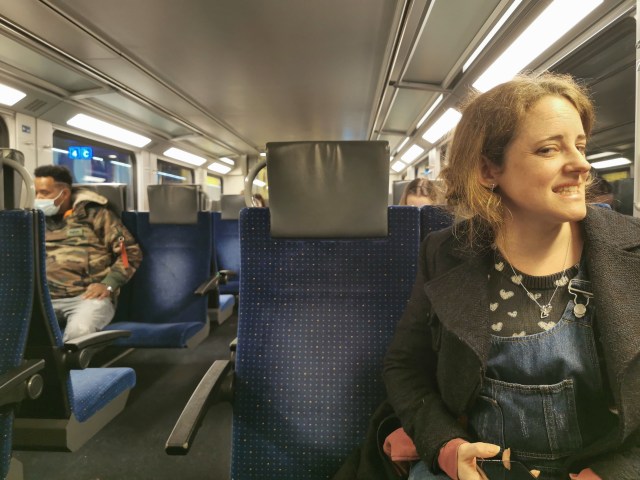

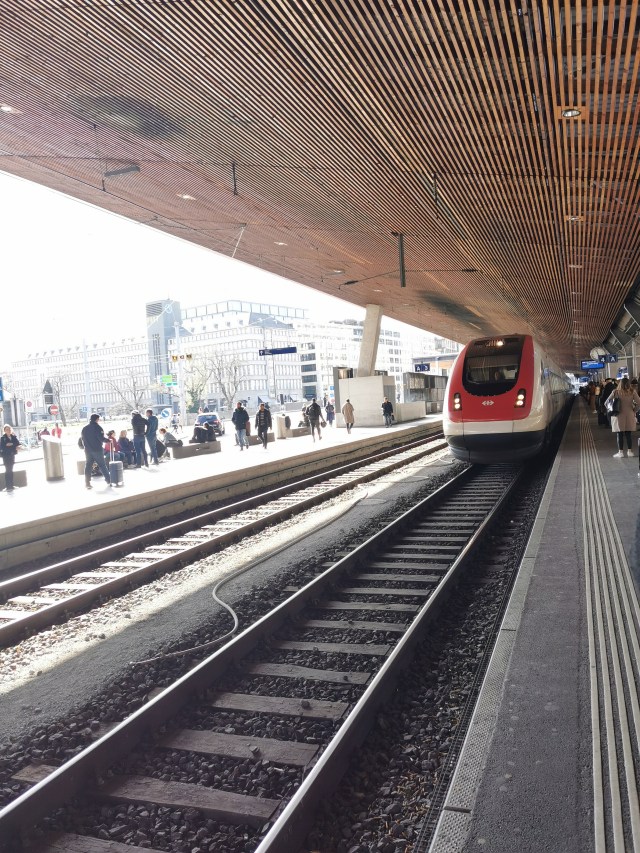
While the train – as mentioned above – is an easy way to explore Zürich and Switzerland, for me there is nothing like getting out onto the open road and setting your own itinerary.
Hiring a car can be done directly from the Airport and even though Holly and I only wanted to hire a car for a single day it was easy for us to make the short hop back to the airport from the city centre to pick up our car from Europcar hire.
It’s worth pointing out that there are numerous other car hire desks to pick from, but we went with Europcar as we’d used them before and the check-out is extremely straight-forward.
Hiring a car is slightly costly in Switzerland. For the basic small car we hired for the day, it cost us £51.99 up front, which we paid online to reserve the vehicle, and then a further CHF155.03 (or around £130) when we picked it up. You also have to ensure the car is full of fuel upon your return.
When you go to collect the car you’ll need a few things with you. Firstly, you’ll need your driver’s licence to show you are legally allowed to drive. Secondly you’ll also need a credit card where the company will hold a deposit against your rental just in case you damage the car or get a speeding ticket. If you’re careful, both of these things are unlikely.
Once you’re in the car there are a number of things to remember. Firstly, unlike in the UK, motorists drive on the right-hand side of the road in Switzerland and overtake on the left – which can take some adjustment if you’re used to driving on the left.
The next thing is that the road signs and speeds are in kilometres per hour rather than miles. It takes a little bit to get your head around as speeds feel very different mentally when you’re trying to adjust how quickly you’re driving.
The next thing you need is a motorway vignette. This came as news to me as it wasn’t something I even knew existed before arriving in Switzerland. The vignette is basically a pass that allows you to take a car onto the country’s motorways. Without such as pass you’re not allowed to drive on the motorways and could face a heavy fine.
Fortunately, all hire cars come with a vignette in place so no further payments are required. However, if you are bringing your own car as part of a European bigger trip, for instance, then you’ll need to buy one online (or at the countries border) before you enter Switzerland.
Hiring a car was the best decision Holly and I made ahead of this trip. We were able to explore a chunk of the country and also allowed us to drive to Liechtenstein; a country landlocked between Switzerland and Austria that has no airport nor central train station.
Ahead of the trip, we planned out a circular route that would take in a number of sites (including Liechtenstein). Our route was a 350km roundtrip that started at Zürich Airport and took in the Stoos Funicular, Liechtenstein, St Gallen and back to Zürich Airport (more on those sites later).
After getting away from Zürich Airport – where the roads are understandably busy (unavoidable and not an ideal way to start driving in a foreign country) the roads open up and you get to see some wonderful mountain scenery as you venture further away from the city.
It’s hard to describe how beautiful the Swiss surrounding area is, but those who take a car out will soon see it for themselves.
If you do follow a similar route to the one we did, you’ll be taken towards the Alps. The only way the Swiss have been able to make suitable road networks in these areas are by tunnelling through the extremely solid rock that makes up these enormous mountains. You spend a fair bit of time initially driving through a series of mountain tunnels which sadly obscures the scenery. Yet, when you come out the other side you are quickly reminded of how beautiful a place you are in.
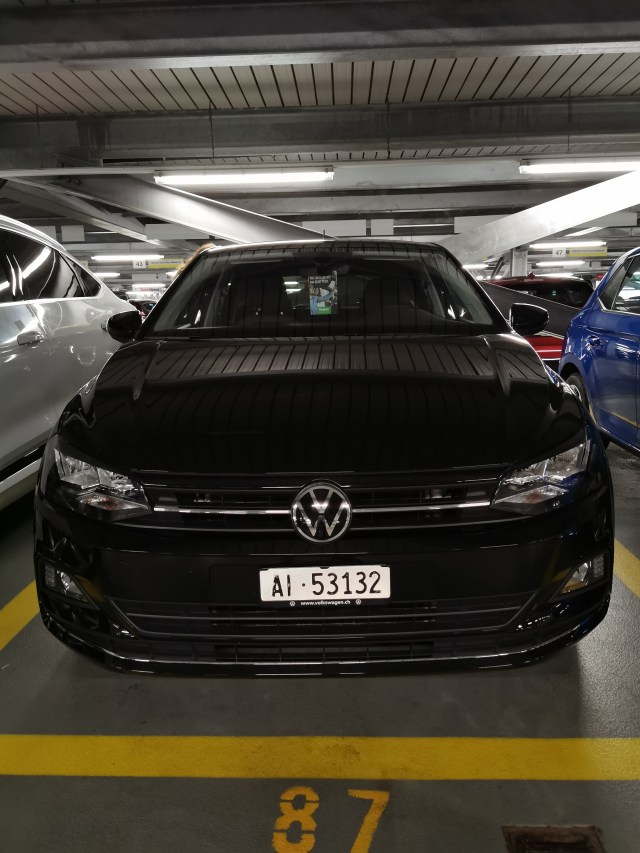
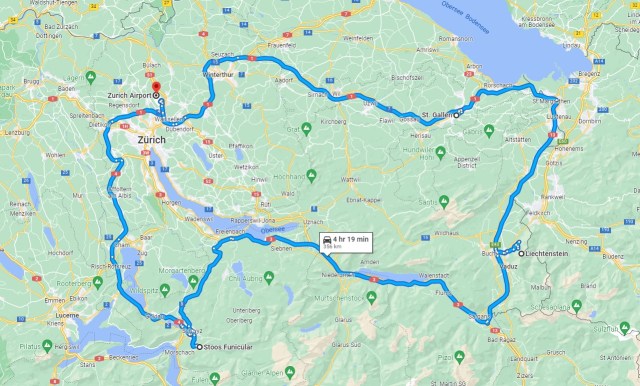
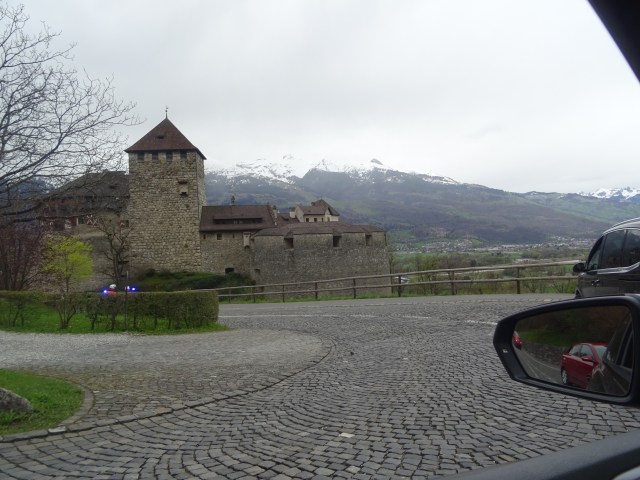
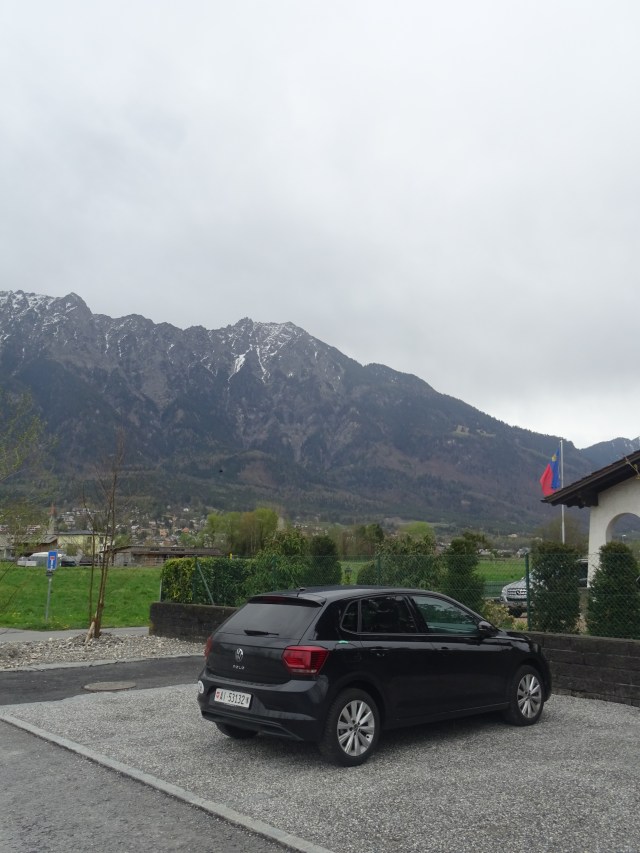
Back in Zürich, my final suggestion for ways to get around is by using the tram.
While Holly and I never actually used the service ourselves, we saw just how prevalent they are in the city and how easy they appear to be to use.
Run by the Zürich Transport Network (ZVV), the electric trams have rumbled through the streets of the city since the late 1800s. Today, there are 15 tram routes and more than 300 trams plying 172km (107 miles) of track.
Tram and bus stops are clearly signposted, with route numbers listed. Trams going in different directions on the same route will stop on opposite sides of the street or tram platforms.
To give you an idea of costs, a single-ride ticket for those traveling within two zones will cost around CHF4.40 (about £3.70) and are good for one hour, with transfers permitted.
Top sites
You’ll be pleased to read that Zürich is blessed with many great things to see and do which will delight both those who love nature and those more fond of city living.
The first must-see, and must-do, is a trip down to Lake Zürich and then a ride on the lake on the Lake Zürich river boat.
Spanning some 40km, Lake Zürich is a central draw to life in the city with a lot of activities taking place around it or on it.
With the mountainous backdrop visible from the city, the lake is a tranquil and peaceful setting to enjoy.
And while taking a walk around part of it is worth doing, the best way to see the lake and the surrounding views is by getting on it.
There are many spots around the lake where you can get on one of the boats – run by Zürichsee – and a wide-ranging timetable of different length trips to choose from.
For us – and many others staying in Zürich – the easiest place to board a vessel is at the city’s Zürich Bürkliplatz dock. Located just at the entrance to the Lake Zürich from the city centre, this dock has regular trips departing.
There are three main cruise lengths to choose from; the mini lake cruise which takes up to two hours, the short lake cruise which takes a little over two hours and the long lake cruise which can take around three hours.
Prices are extremely reasonable also. The mini lake cruise costs just CHF6.80 per adult, the short lake cruise (the option Holly and I selected) costs CHF8.80 while the long lake cruise costs CHF26. To pay for the cruise, you can either queue up for a ticket or – if like us you are jumping onboard at the last possible moment – you can pay as you board by cash or card.
Once on, there are usually plenty of seats and tables available both inside and outside (depending on the weather) and there will also be drinks and food options available to you which will be served to your table allowing you to soak in the sights.
Each cruise will make numerous stops at different docks to allow people on and off, but these stops are short and give you a few moments to enjoy the scenery and grab a photo or two.




The next thing to see in Zürich is the Heureka Useless Machine.
While this sculpture can be seen as part of the river boat cruise, the best way to see it in all its pointless glory is to take a short walk around a section of Lake Zürich.
Holly and I only came to know of this amusing piece of art’s existence having watched the Channel Four show Travel Man where – for one episode – they spent time in Zürich and highlighted this totally pointless piece of artwork. From that moment on, we knew we had to go and see it ourselves!
The work was made by Swiss sculptor Jean Tinguely who has become best-known for his no-purpose kinetic artworks. Heureka one such useless machine.
The statue is located towards the edge of the Zürichhorn waterside park. This is a good 40 minute walk from the city centre and is around 3km in each direction. While you’ll need to have a decent level of fitness to do this, the walk is pretty flat and picturesque. Because of this, it’s not the hardest walk ever (to give you an idea, Holly was a good few months’ pregnant at the time we did this) but offers little shelter if it’s a wet day.
The title, Heureka, is Ancient Greek for “I’ve got it!” This is meant to be ironic. The sculpture, created in 1964, is an allegory of consumerism in advanced industrial societies.
At set intervals the machine spurns into life and churns and churns with no purpose other than pure absurdity.
The sculpture is made from everyday objects like scrap metal and junk. It’s comprised of various tubes, wheels, iron bars, metal pipes, and electric motors assembled together to create an intricate machine when turned on — or rather, the illusion of one.
The sculpture is a good target point for those looking to walk a section of Lake Zürich as it will give you something to aim for while taking in a good chunk of the scenery. Advise here is to keep your walk near the waterside, because if you go to the street there are limited shops and restaurants to look in and the views are far less interesting.
And best of all about this sculpture; it’s a public piece of artwork so it’s totally free to view in all it’s nonsensical wonder.


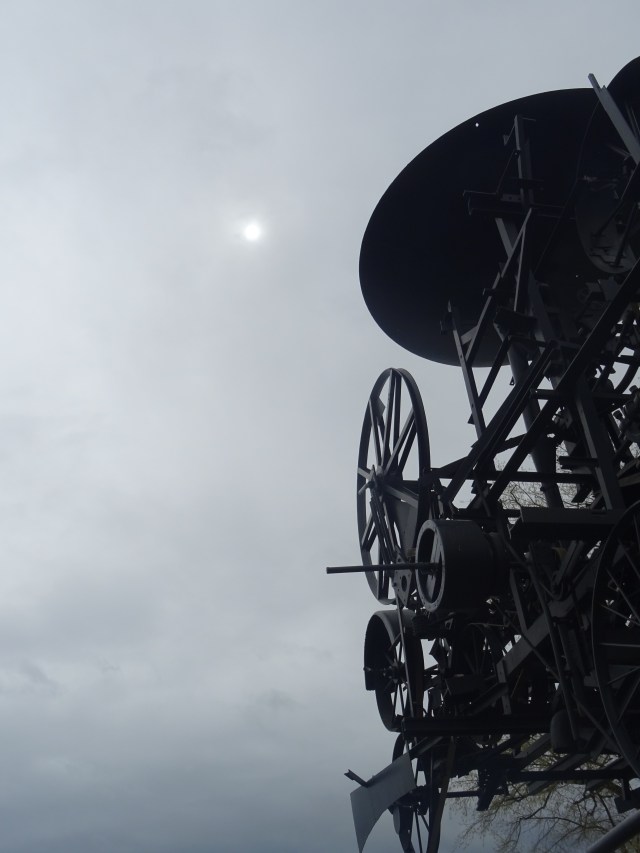
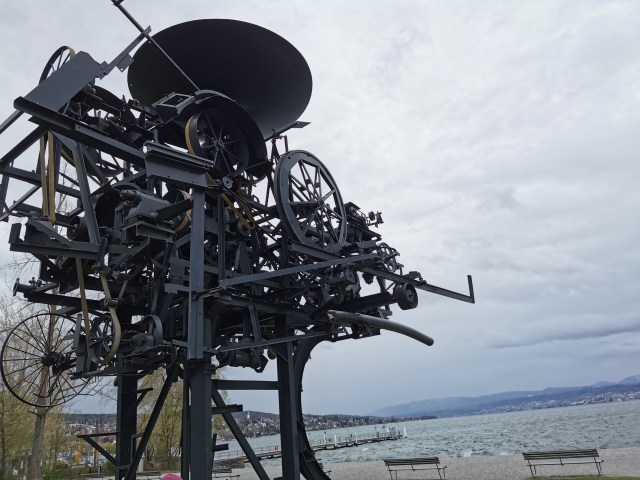
The first of the major churches in the city to visit is the Grossmünster Church.
The two towers of the Grossmünster are, perhaps, regarded as the most recognised landmark in Zürich and as one of the four major churches in the city (the others being the Fraumünster, Predigerkirche and St. Peter’s). Located near the head of Lake Zürich, any visitor to the city will not be able to miss this easily seen landmark.
The church is a large and spacious affair with beautifully decorated walls, windows and ceilings to admire.
However, the main reason I wanted to visit this church – as a non-Christian – is that you can pay a small fee (just CHF5 or around £4.27) and climb one of the two towers to see spectacular views of the city.
There are a few things to note before heading to the small door near the rear of the inside of the church – with your ticket – to make the climb. The first thing is that the route is not disability friendly.
The way up – and down – the tower is the same route and the first portion of the climb is a narrow spiral staircase. If you meet someone coming the other way on this you have to squeeze past each other as best you can. Sadly, this meant that a very pregnant Holly wasn’t able to ascend the tower, leaving the climb to be undertaken by myself alone.
The second thing to note – linked to the first – is that if you want to climb up the tower to the top and get a marvellous view of the city, you need to negotiate a almost 200 stairs which are quite old. As a word of caution, elderly people, those with a fear of heights or those with health concerns should be careful; yet once at the top, the effort is really worth it.
The space at the top is a bit cramped but you will have a 360-degree view and it is quite a treat.

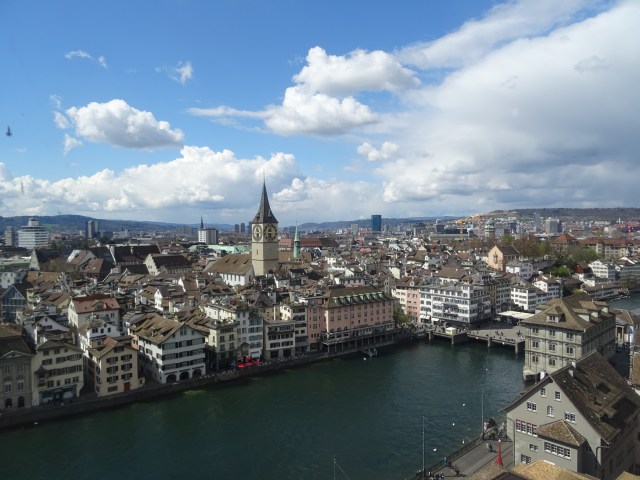


The second religious building worth visiting is on the other side of the river from Grossmünster and is known as the Fraumünster Church.
Located on the west bank of the Limmat, the Fraumünster Church with its green steeple is another one of Zürich’s most prominent landmarks that is particularly recognisable for its renowned glass windows.
The church was built from the middle of the 9th century. Today, many visitors are attracted by the five stained glass windows prepared by Marc Chagall in the 1960s as well as by the the rosette in the south transept. Another significant glass window is “The Heavenly Paradise” (dating to 1945) by Augusto Giacometti in the north transept.
Perhaps even more so than that of Grossmünster, Fraumünster exudes beauty both outside and within.
Yet, like other churches in Zürich, Fraumünster – also known as the Minster of Our Lady – welcomes worshippers for free, but an entrance fee of CHF5 (around £4.27) applies for each person 17 and older not attending a service.
For that entrance fee, you get to look around the church and explore the Fraumünster Crypt that was only made public in June 2016.
The foundations of the crypt date back to the 9th century when the abbey was founded. The crypt comprises of an exhibition on the history of the Reformation in Zürich, the architecture and the local history. All of this is assisted by a multimedia information system that illustrates the foundation fragments of the crypt, and how the church was rebuilt from the original Romanesque construction phase to its present Gothic appearance.



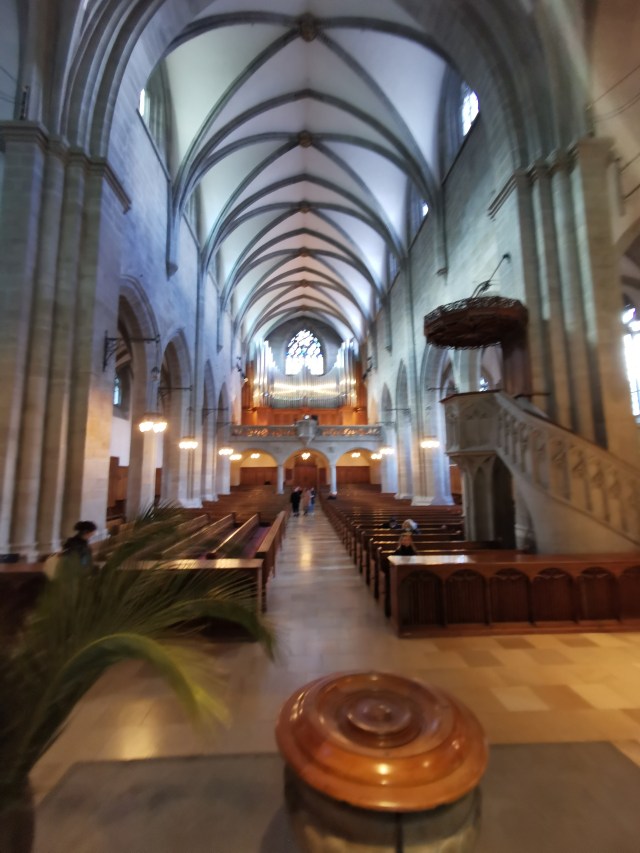
Away from churches, there are a number of great places within Zürich to get a great view of the city.
One of these that Holly and I stumbled upon was the very quaint and charming Polybahn funicular leading up to the Polyterrasse.
This extremely short funicular links the central square – located on the corner of a road named Limmatquai – with the terrace by the main building of the Federal Institute of Technology (ETH) Zürich.
For just CHF1.20 (around £1) per person we took the three minute ride up the hill’s 176m of track.
The system is an ingenious design which has its origins dating back to 1889 when it first opened.
The Polybahn consists of two cars that are connected by a cable. The two cars are designed to counterbalance each other like a pair of old-fashioned elevators. As the car on the left climbs the track, the car on the right descends. They pass each other in the middle, with the left car reaching the upper station as its twin arrives in the lower station. The cars then discharge their passengers, collect new payloads, and repeat the three-minute cycle.
Boarding nice and quickly, grab a place by the window and check out the charming track as you make your way up or down the hill.
Once at the top, Holly and I made our way to the Polyterrasse.
This free-to-view terrace affords great vistas of the city centre and across to the lake.
The Polyterrasse sits in front of the the imposing ETH building – that was constructed back in 1864 – and provides many places for visitors to gaze across the city.
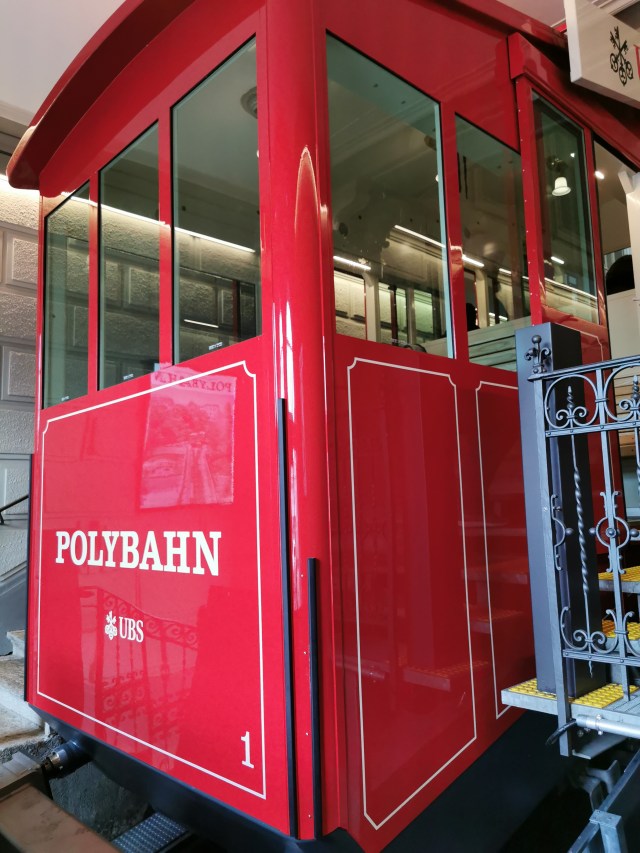

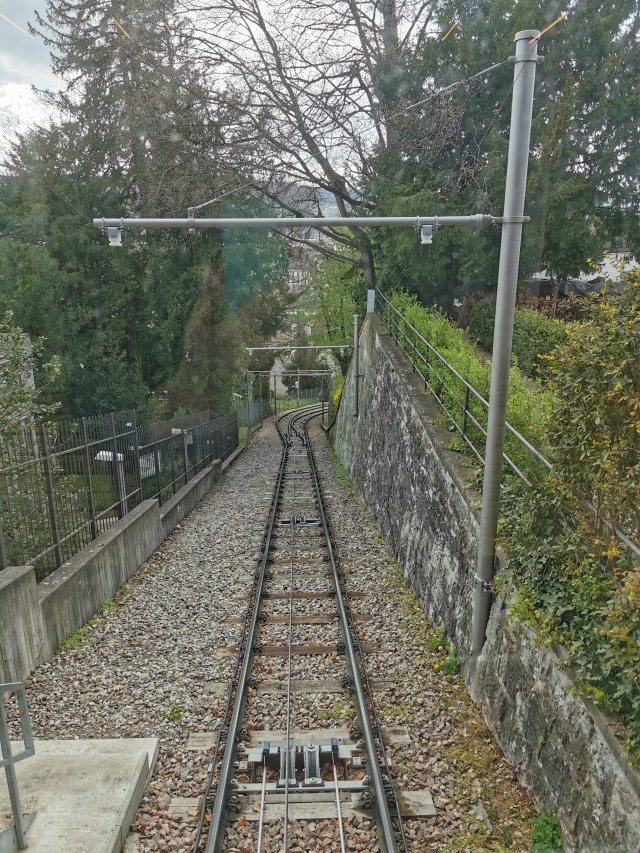
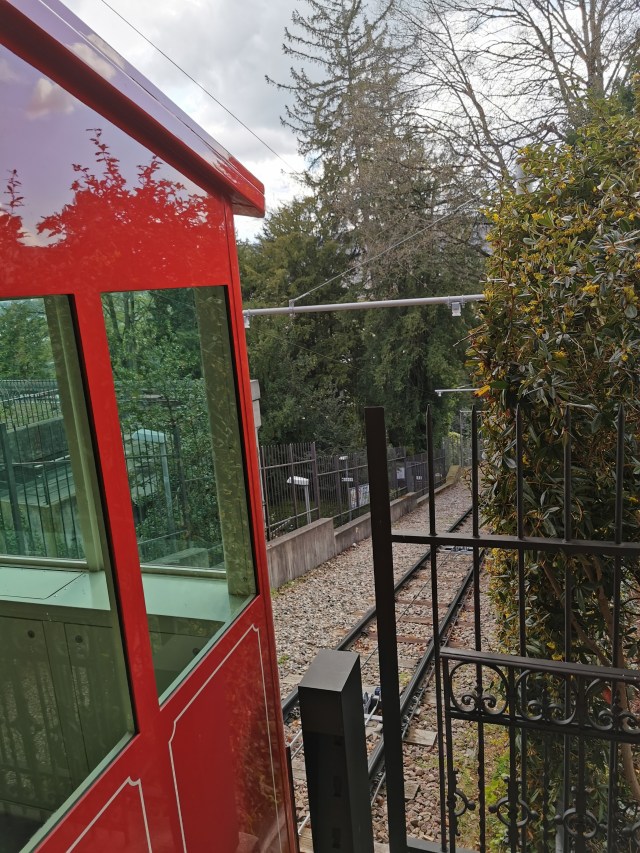

As a massive football fan, there was no way I was heading to Zürich without making a stop at the world-famous FIFA Museum.
Purchasing tickets for myself and Holly online before we left for CHF24 (around £20.50) I was excited to take a walk around a museum that celebrates all things football!
Making the 20 minute walk from the city centre to the museum’s entrance – located on a road called Seestrasse – we entered and scanned our tickets through the automated turnstiles.
The museum is then split over a three floors.
The first of these is Floor Zero and is known as Planet Football. This floor is a celebration of FIFA’s member associations – all 211 of them. Here we spent time looking at the ‘Rainbow’ of national team’s shirt before taking a whistle-stop tour through the history of football in their exhibition called The Timeline.
From here we descended to level -2, and entered the historic heart of the museum. The first stop is The Foundations, which pays tribute to football’s pioneers. That’s followed by The FIFA World Cup Gallery.
What I didn’t realise before my visit was that they actually have the real FIFA World Cup Trophy and the FIFA Women’s World Cup Trophy on display here and we were able to get up close and personal with them (and a glass case of course) to grab some much needed photos!
The final floor is an interactive one and is filled with a multitude of attractions. Known as the Fields of Play, this floor gives visitors the opportunity to hear the impact football has had on society and learn about football in The Lab. This is then finished off with some great fun games where you try and score as many points as you can across a number of different skill-sets.
While this was great fun, I hate to admit that Holly – despite being pregnant – still managed to beat me on this! A very embarrassing end to the trip. With my tail firmly between my legs, we made our way out – via the gift shop – having spent a good couple of hours enjoying the world of football.
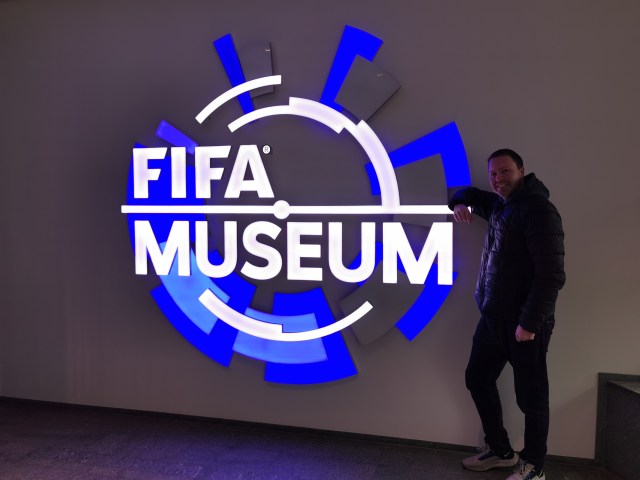

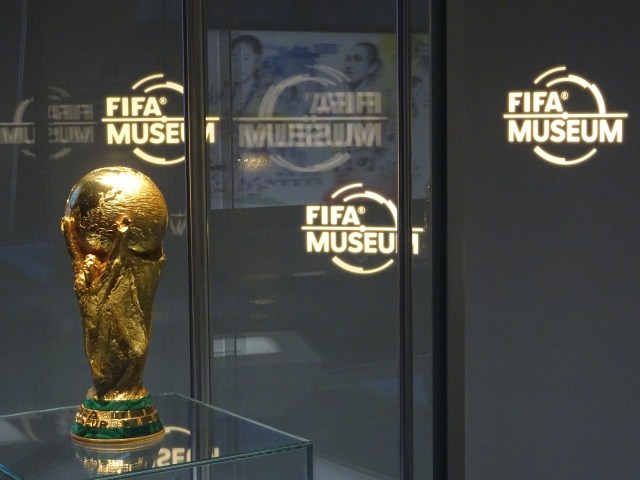
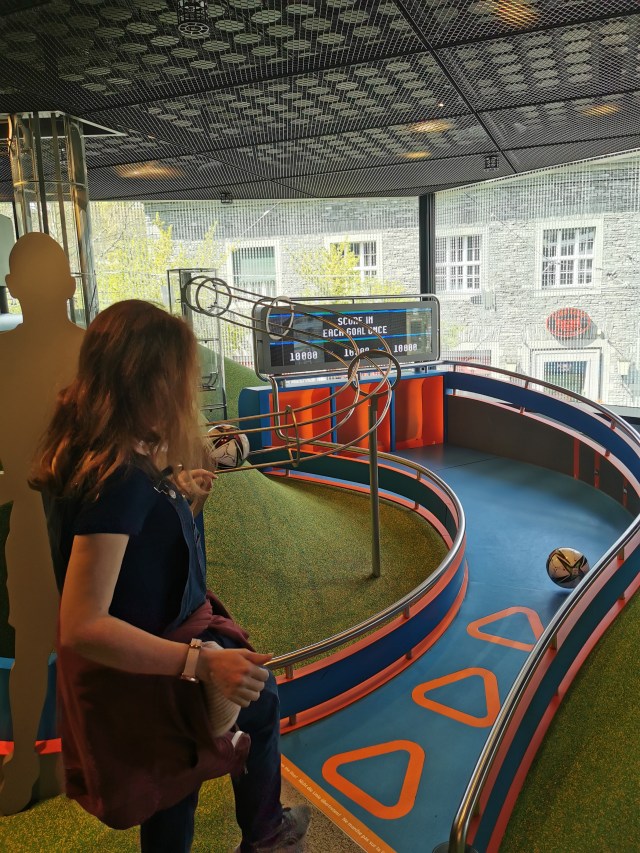
Away from Zürich – via the hire of a car – you can find the magical Stoos Funicular.
The Stoosbahn – also known as the Schwyz–Stoos funicular – is a funicular railway in the Swiss canton of Schwyz. It connects the Hintere Schlattli in the municipalities of Muotatal, Morschach, and Schwyz with the village and mountain resort of Stoos, above Morschach.
At a length of 1.7km (Around 1.1 miles), its track rises some 744m (2,441 ft) up and has a maximum gradient of 110% (47.7°) making it the steepest funicular railway in Europe!
Holly and I only became aware of this engineering feat a few weeks before our trip and quickly made sure we could shoehorn a visit to it during our day on the road.
Arriving mid-morning in Stoos – after taking in the sights as we drove an hour south from Zürich – we arrived at the deserted funicular station at the foot of the mountain wondering if our pre-booked tickets (costing us 22CHF per person – around £19) were going to go to waste.
Parking in the large multi-story car park to the side of the funicular station we made our way inside and thankfully saw the railway was running.
The truth of the matter was that our trip did not coincide with the ski season, and therefore, nobody else was heading up the mountain other than a few local workers.
Boarding the front train carriage – which would be a lot harder if it was busy – we placed ourselves in the window and awaited our departure.
Soon enough we were being transported up the side of the mountain. The incline grew ever more precarious, but the genius design of the train means you don’t feel a thing in terms of the tilt.
Through a tunnel in the mountain, we emerged out of the other side and to our delight were welcomed by a snowy wonderland. Holly’s face lit up like I’ve not seen before when she saw just how much snow we would be in! The one down side of this was that neither of us had dressed for snow – beyond a winter jacket – so our time on top of the mountain would be a slightly chilly one.
Yet it was worth every cold second of it. Departing the train we spent a good hour walking around the deserted ski village while enjoying the snow. It’s not every day you get a place like this pretty much to yourself!
For longer stays here, there are an array of shops, bars and restaurants as well as accommodation aplenty. And aside from the skiing, there are also a number of mountain walks that you can do to varying difficulties.
Making our way back to the funicular station, we boarded the train and enjoyed the views one last time as we made our way back down the mountain, to collect our car from the car park before heading off towards Liechtenstein.



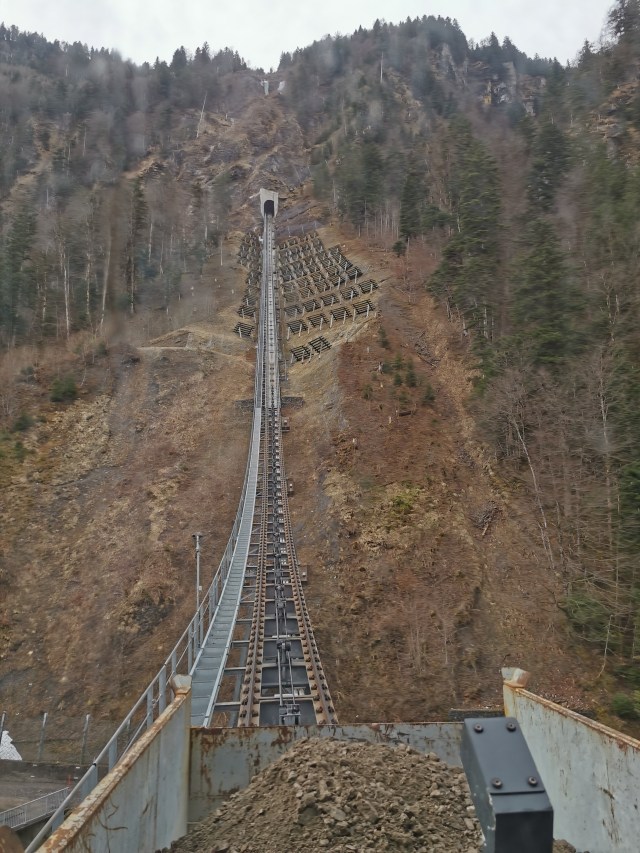

As I may have mentioned, this road trip was designed to get Holly and myself to the micro-nation of Liechtenstein.
The Principality of Liechtenstein is bordered by Switzerland to the west and south and Austria to the east and north. It is one of Europe’s smallest countries, with an area of just over 160 square kilometres (62 square miles) and a population of 38,749 (as of 2019).
With no airport of its own (Liechtenstein is one of only a few countries without an airport; with its nearest major airport being Zürich some 130km or 80 miles away by road), to get here you can get a train to one of the countries four train stations (none of which are well serviced or central) or do as we did and drive the 110km scenic journey through a portion of the Alps.
Situated in the Upper Rhine valley of the European Alps, the country itself is very Swiss in nature. They accept Swiss money as their own and a lot of their culture stems from their close ties with Switzerland.
There is also no hard boarder between the two countries. To enter Liechtenstein from Switzerland you can either walk or drive across one of the bridges.
As a lover of these quirky and unique national borders, getting to drive us across was a goal of mine that I was able to fulfil as Holly and I made our way to the centre of the country’s mini capital city, Vaduz.


The capital of Liechtenstein – Vaduz – was the main target of our trip to this micronation.
The city, which is located along the Rhine River, has 5,696 residents and the city’s most prominent landmark is Vaduz Castle (more on that in a bit) which is visible from almost any location in the city with it being perched atop a steep hill.
After entering the country we quickly found a small car park to park up before setting out on-foot to explore the city centre.
The first thing that’s noticeable about this city – other that its small size – is that it’s very quiet. The streets were very empty and the traffic was minimal where cars were allowed.
One of the main streets within the city itself – called Städtle – is mainly pedestrianised and houses numerous pieces of interesting street art (keep your eyes open for various sculptures including The African King (a large mask-like face), Grande Cavallo (a pair of bronze stallions) and the Reclining Woman (a large statue of a naked lady just off the main street).
There are also a number of museum’s within Vaduz but, unfortunately, time didn’t allow us to visit any of these during our trip.
The city centre is also a great place to grab some lunch before exploring further afield and there are plenty of eateries to choose from.
As a top tip for Vaduz, pay a small CHF3 (about £2.60) fee at any tourist office within the city and get a Liechtenstein stamp in your passport! As someone who loves getting their passport stamped with a new place, I couldn’t pass up this opportunity as you don’t get anything when you enter the country.
Also as you explore the area, keep an eye out for the Rathaus Vaduz at the north end of the city as well as Das Rote Haus which sits further north still as these both make great photo opportunities.




While the city is picturesque, the main draw of is Vaduz Castle which, to this day, remains the palace and official residence of the Prince of Liechtenstein.
First thing to say here is that this is not a castle you can enter and explore given its functional role in the city. Yet, despite this it is still well worth the climb up the road to go and see it.
Holly and I walked the winding pathway along the roadside towards the castle and made it there within 30 minutes from the city centre. Just as we rounded the final corner of our climb we then – annoyingly – remembered that the parking ticket on the car was about to run out! With Holly pregnant, this meant that I took a quick jog down the hill back to the car. Thank god this was all downhill as I doubt I’d have made it in time otherwise!
I then drove the car back up the road to meet Holly who remained by the castle and parked up just beyond its fortified walls at a small parking spot on a road called Bergstrasse.
As far as I could tell, parking here is free and is used for those who wish to see the castle. There was no obvious place to pay-and-display so this was ideal.
The castle tower stands on a piece of ground that is 12m by 13m (39 by 43 feet) in area. At the ground floor, the tower walls have a thickness of up to 4m (13 feet).
With the backdrop of the Alps, this castle is a spectacular viewing platform. Overlooking the whole city – and out across a part of Switzerland – this made the trip to the region all the more special.
A final ‘treat’ happened when – as we were departing to drive back down the hill – the Prince of Liechtenstein was also leaving which saw us stuck in a small traffic jam as the local police escorted the Prince to whatever duty he was undertaking.
While we didn’t get to see him in person, we did see his royal car driving away and followed it for a portion of our own journey before heading off in a different direction.



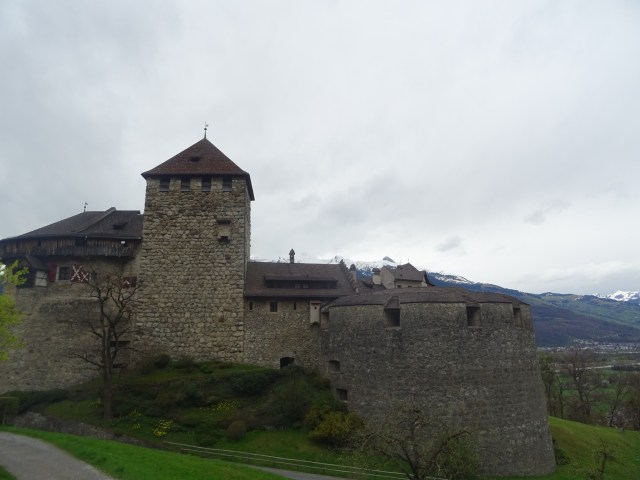
As a football fan (as I previously mentioned) I enjoy visiting all sorts of new football stadiums whenever I can. Therefore I wasn’t going to pass up the opportunity to see the Rheinpark Stadion.
The stadium plays host to the home matches of the Liechtenstein national football team, and is also the home of club-side FC Vaduz. It lies on the banks of the Rhine, just metres from the border with Switzerland.
So while there was no game scheduled to play (much to Holly’s delight) during our visit, I was still able to pull over near the stadium entrance and have a peak around the corners of the gates to take a look inside.
The small stadium holds just over 7,500 fans and is blessed with a perfect backdrop for spectators to enjoy if the game isn’t any good. A must see for all football supporters.


The final spot to see is a slightly odd one as – realistically speaking – there is nothing there to see! However, it is symbolically special as it’s one of the few spots on the globe where three separate nations’ borders meet.
The Switzerland / Liechtenstein / Austria tri-border technically meets in the middle of the river making it impossible to stand on but you can get the feel for it all the same.
Leaving Liechtenstein and driving through the Swiss village of Sennwald, we made our way to the tri-border and parked our car on the Swiss-side and down what can be best described as a bit of waste land.
With our passports in our pockets (just in case of any issues) we headed out on foot to cross the Rhine Bridge. This bridge connects the road known as Zollstrasse in Switzerland (where we passed a deserted hut where I assumed a border guard once sat) on one side of the river to the road named Rheinstrasse in Austria on the other.
As far as we could see we were not breaking any rules doing this and there were no border guards anywhere to be seen. Once on the other side of the river we passed a sign that said we had entered Austria.
Further down the road there were a number huts on the Austrian side but as we didn’t want to venture too far into Austria we headed back across the bridge into Switzerland to collect our hire car and be on our way.

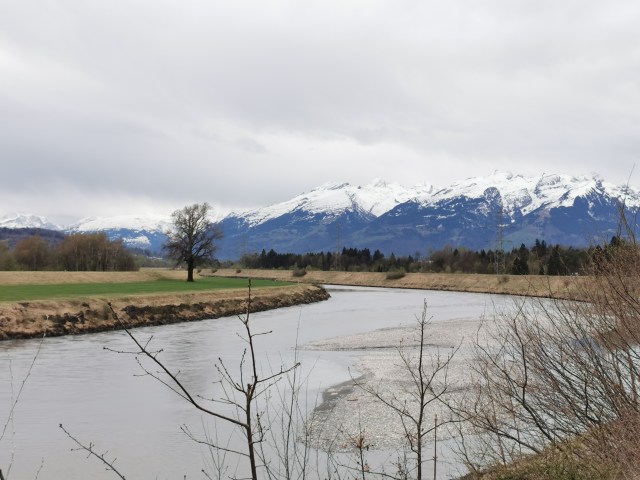

Where to avoid
First thing to point out is that, from my experience, Switzerland is an extremely safe country to visit. While crime obviously exists, if you are careful – as most will be when travelling – and you can keep your possessions safely stored and money secure, then it is unlikely you’ll experience any problems.
So with that in mind, this section will look at a couple of places that could be skipped if time is not on your side.
The first of these is the Church of St. Peter.
This parish church in the centre of Zürich sits near the lake as well as near the aforementioned Grossmünster and Fraumünster churches.
If you have already seen the other two churches then you’ll not be missing much if you skipped this one.
My reasons for this are that, the Church of St. Peter is the least interesting of the trio. For starters, it is the smallest of the three and secondly, the insides, while pleasant, are not very exciting to look at. A plus point is that it is free to enter.
The best way to see this site is from the outside where you can get a view of its 8.7m diameter clock face (although this can be done from other vantage points in the city without having to walk over to the church.



My second suggestion of an attraction to not seek out is the Zoological Museum – UZH.
Before I say too much about it, I’ll point out the positives are that it is free to enter, easy to get to (located near the Polyterrasse) and has a good amount of information available on its displays.
That being said, the museum itself – which is a showcase for the University of Zürich and established in 1833 at the same time as the university itself – is quite small and can get fairly busy (around 140,000 visitors come through its doors each year). This makes looking at some of the exhibits slightly difficult and rushed as you jostle for positions with the crowd.
The main attraction inside, is the museum’s 1,500 stuffed animals it has on display. Some of these are enjoyable to look at and read about while others have clearly seen their best days go by. It’s also not a place for those who don’t like, or are freaked out by, taxidermy!
Holly and I spent around 45 minutes exploring the museum before making our way outside. Again, if you find yourself with time to spare and in the area then it may be worth a flying visit. I’d just suggest you don’t select this attraction over doing something else that could be more rewarding.

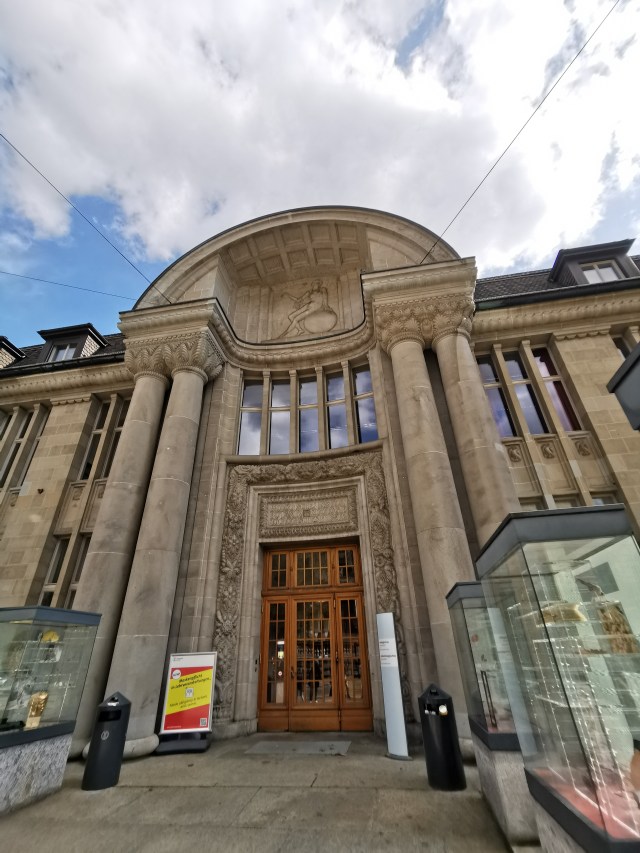
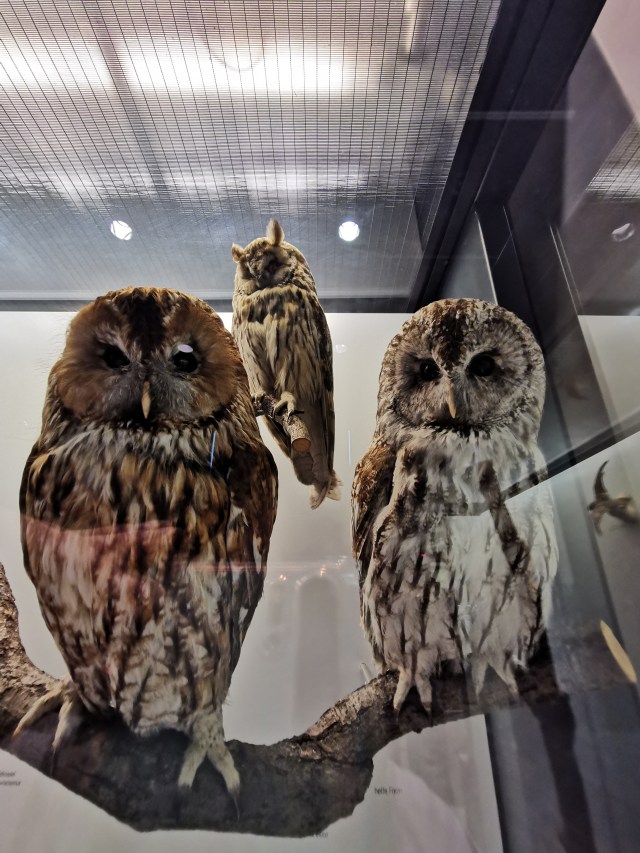
Great places to eat
As you’d expect, Zürich is littered with great places to eat and wonderful foods to try.
Quintessential local dishes include Zurcher geschnetzeltes (Zürich-style sliced veal in gravy), “rosti” (shredded fried potatoes), “burli” (crusty bread rolls) and Raclette (melted cheese scraping that is then served with boiled potatoes).
And that’s just the savoury food. No trip to Switzerland would be complete without a generous helping of Swiss chocolate (for those looking to indulge, look no further than the Lindt shop – spread over a number of floors – in the centre of the city on a road named Bahnhofstrasse).

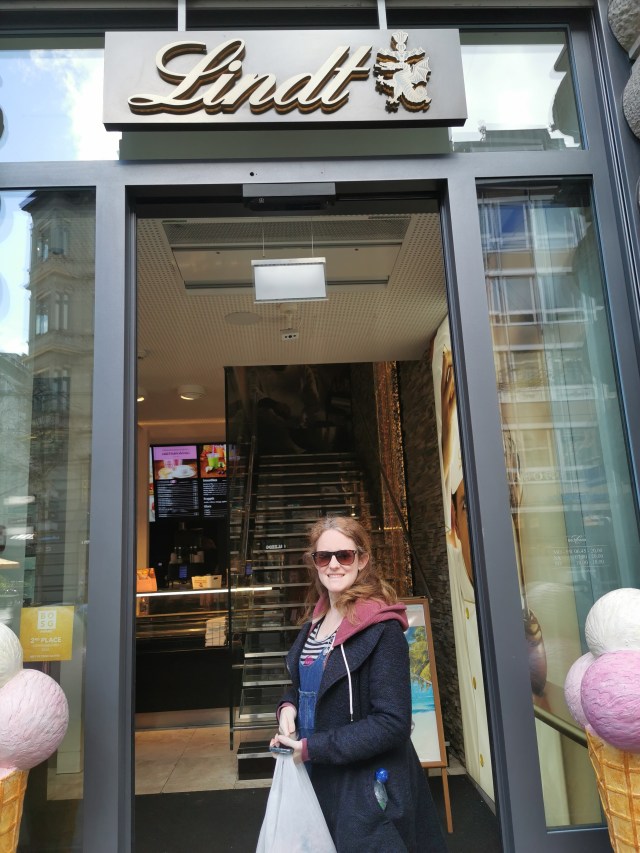

But as well as enjoying plenty of places where you can indulge your inner-chocolate-loving child, there are some great restaurants around the city that are worth checking out also.
There were two restaurants in particular that I was fond of during my time in Zürich. Both were relatively inexpensive (for Switzerland) and both provided enjoyable food and good service.
The first of these was The Butcher.
This burger joint has a number of locations around Zürich but the one Holly and I enjoyed eating at was located on a side road that runs parallel with the river called Stüssihofstatt.
The restaurant prides itself on having ‘homemade’ food and the burgers that you order and plentiful and delicious.
The menu caters to all tastes and has a variety of beef, chicken and pork burgers, as well as a wide selection of plant-based options for vegetarians to enjoy.
Most burgers cost between CHF15 and CHF20 (about £13 – £20 ) and can be complimented well with some of the Butcher fries which are available for around CHF7 (about £6).
For those who make their way through the burgers, leave a little room for one of their delicious desserts!
To give you an idea, for two people to enjoy a burger and fries each, along with a drink and dessert, it cost us around CHF70 (around £60); a fairly cheap price by Swiss standards and overall, money well spent!

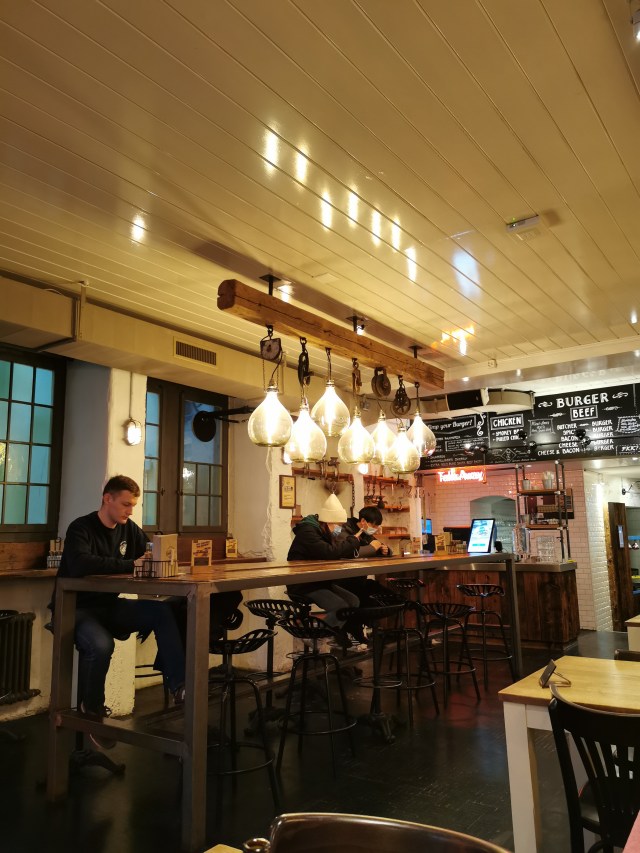


The second choice for us was Restaurant Zeughauskeller which is situated on Bahnhofstrasse near the upper end of Lake Zürich.
This large open hall once acted as an armory – having been built in 1487. Nowadays, the arsenal is a peaceful and sociable house and the weapons on the walls are only used for decoration.
Entering this restaurant, the scene before you seems somewhat chaotic. People are seated everywhere and staff carry large platters of food between the throngs of hungry guests – somehow avoiding walking into them and sending the tasty treats everywhere.
Once seated, on the menu you find a good selection of traditional dishes based on recipes that have been cherished and refined for centuries. A wide range of hearty meat dishes, special sausages and world famous Swiss specialities will tempt you to try them and huge glasses of beer are on tap to help you wash it down.
Price-wise, you’ll be looking at a similar bill to that of The Butcher (around CHF70 or £60) for a meal and drinks for two and you’ll certainly leave here full to bursting both from the great food and the copious amounts of drink you’ll consume.



Useful links
Switzerland / Liechtenstein / Austria tri-border
Remember you can follow World Complete on Twitter, Instagram, Pintrest, Tumblr and Facebook send your comments and pictures from your travels using #WorldComplete and #Travel.


Glad you enjoyed your trip to Zürich. I used to go there fairly often (https://operasandcycling.com/category/switzerland/zurich/) and in fact just went through on the train last week on my way to somewhere else.
LikeLiked by 1 person
Thank you for taking the time to stop by. Hope you liked the blog. 😄
LikeLiked by 1 person
Zurich is such a great city. I’ve only spend a day there but I really enjoyed. Thanks for sharing your experiences.
LikeLiked by 1 person
No problem. Highly suggest you go back if you get a chance👍Thanks for stopping by.
LikeLiked by 1 person
Zurich looks a fabulous place to visit and it’s been on our to do list for a long time. Great post, we can see a lot of work went into it!
LikeLiked by 1 person
Thanks so much for the kind comments and for stopping by. Glad you enjoyed the post. Loved Zurich. Was such a fun trip.
LikeLike
Such a thorough and informative post. Thank you for all of the information and the links, this will be added to the list!
LikeLiked by 1 person
Thanks so much for stopping by. Really glad you enjoyed my blog and found it interesting and helpful. Please feel free to check out some of my other posts at http://www.world-complete.com
LikeLike